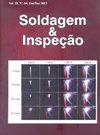高强度低合金钢焊接过程中的热-机械-冶金耦合模型
IF 0.3
4区 材料科学
Q4 METALLURGY & METALLURGICAL ENGINEERING
引用次数: 1
摘要
摘要:预测金属合金焊接过程中发生的转变,以控制焊件的性能是一个众所周知的挑战。因此,本研究提出了一种热-机械-冶金模型,用于数值预测高强度低合金钢焊接过程和焊接后的热历史、固相转变、凝固组织和硬度分布。该模型在基于有限体积法的内部计算程序中进行了数值实现,该程序可以动态跟踪和计算热影响区铁素体、珠光体、贝氏体和马氏体的体积分数,以及熔合区枝晶臂间距的形成和确定,而热影响区硬度分布则采用相混合规则计算。为此,对高强度低合金AISI 4130钢试样进行了单道次自保护气体钨极弧焊焊缝的数值模拟和实验,并对其进行了预热,以评估所提出的模型在不同初始热条件下模拟工件焊接的有效性,计算结果与实验结果吻合较好。本文章由计算机程序翻译,如有差异,请以英文原文为准。
A Coupled Thermo-Mechanical-Metallurgical Model Capturing Essential Transformations in the Welding of High Strength Low-Alloy Steels
Abstract: A well-known challenge is to predict the transformations occurring during the metal alloys welding aiming to control the weldment properties. Thus, this study presents a Thermo-Mechanical-Metallurgical model to numerically predict the thermal history, the solid-state phase transformations, the solidification microstructure and the hardness distribution during and after the welding of high strength low-alloy steels. The model was numerically implemented in an in-house computational code based on the Finite Volume Method, which allowed to dynamically track and calculate the volume fractions of ferrite, pearlite, bainite and martensite at the heat-affected zone, besides the formation and determination of dendrite arm spacing at the fusion zone, whereas the hardness distribution at the heat-affected zone was calculated by applying the phase mixture rule. For this, single-pass autogenous Gas Tungsten Arc Welding welds were numerically simulated and experimentally carried out on high strength low-alloy AISI 4130 steel samples, including their preheating to evaluate the effectiveness of the proposed model to simulate the workpieces welding in different initial thermal conditions and a close agreement between the calculated and experimental results were obtained.
求助全文
通过发布文献求助,成功后即可免费获取论文全文。
去求助
来源期刊

Soldagem & Inspecao
工程技术-冶金工程
CiteScore
1.00
自引率
16.70%
发文量
13
审稿时长
12 weeks
期刊介绍:
The Journal Soldagem & Inspeção (S&I) js a techno-scientific journal created in 1995. Printed issues of this journal are distributed free of charge to libraries in Brazil, Latin America and the Iberian Peninsula. It has been printed regularly every quarter since September, 2002, and, since the beginning of 2007, its electronic version is available in the address: (http://www.abs-soldagem.org.br/s&i/). The journal is sponsored by the Brazilian Welding Association (ABS).
Since its creation several well known professionals working in welding contributed with the Journal Soldagem & Inspeção and its editorial board crosses the Brazilian borders. During its evolution the Journal received ta special contribution from the Editors-in-chief : Ronaldo Paranhos, Américo Scoti, Paulo Modenesi e Alexandre Bracarence. Since January 2012 the Editor-in-chief is Ana Sofia C. M. D’Oliveira, Full professor at Universidade Federal do Paraná (UFPR) . Her work focus mainly on Hardfacing and Physical Metallurgy. The jornal Soldagem & Inspeção also counts with 10 Associate Editors and a fix Editorial board of referees. short-term (Ad Hoc) referees can be invited to evaluate some papers submitted to the journal.
The Soldagem & Inspeção journal is the scientific divulgation channel of the Brazilian Welding Association (ABS). It aims to publish original papers related to the scientific and technological development of welding, inspection, and related fields. Review papers or letters on current and controversial subjects are also published in the Journal.
Its abbreviated title is Soldag. insp. (Impr.), which should be used in bibliographies, footnotes and bibliographical references and strips.
 求助内容:
求助内容: 应助结果提醒方式:
应助结果提醒方式:


